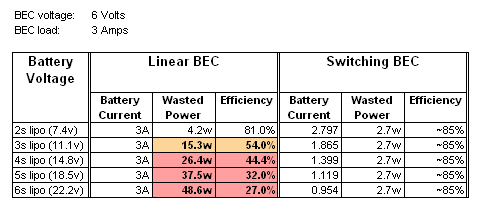 BEC Calculator
BEC Calculator
The general term "BEC" stands for Battery Eliminator Circuit, and is simply a fancy name for a voltage regulator. There are two main types; linear and switching.
A linear regulator converts any excess voltage to heat. When the main battery pack is fairly low (7.2v-10v), there is little wasted heat because there is not much difference between the main battery voltage and the BEC output voltage, which is usually 5v or 6v. When you start using higher voltage batteries, this type of regulator will heat up quite a bit to the point of thermal shutdown. Most ESC manufacturers recommend the use of an external switching BEC (UBEC) or a receiver pack when you use more than 12v to 14v main batteries. However, even at this point, there can still be quite a bit of wasted energy as heat in a linear regulator. As main cell count goes up and/or load current increases, efficiency decreases.
An external switching BEC, sometimes called a UBEC (universal BEC), is the best choice by far. A UBEC is a tiny circuit which also reduces the voltage, but is a switching regulator. This type is MUCH more efficient (typically around 85%), especially at higher main battery cell counts.
I personally recommend using an external switching BEC when using an ESC with a linear BEC and voltages above 7 NiMH cells or 2s lipo.
An alternative would be to use a receiver pack, which is simply a small pack of 4 or 5 small 2/3-size AA batteries to power the receiver and servos. However, this adds to the weight of the vehicle and is just one more thing to charge.
The table below illustrates the advantages of a switching BEC versus a linear BEC. Note how the switching BEC actually draws less main battery current as the cell count goes up. This translates to slightly better runtime out of your main battery pack(s). Also note the high wasted power of the linear BEC at high cell counts.

The information in the table above assumes a constant 3 amp draw on the BEC circuit. However, this is rarely the case as the load will fluctuate quite a bit. As a test, I hooked up a Hitec HS-5945MG steering servo (180oz-in torque and 0.13 sec speed at 6v) to a Spektrum DX3 receiver and measured the current at 6v under typical use:
- The Spektrum Receiver uses 0.06A by itself with no servo attached.
- The servo uses 0.014A when idle (not moving and no load).
- Under typical steering conditions, the receiver and servo together drew peaks of 2.4A with an average of 0.6A.
Use the calculator below to show the differences between using a linear BEC versus a switching BEC based on the main battery voltage you are using and an arbitrary servo load. You should be able to quickly see the advantages of a switching BEC.